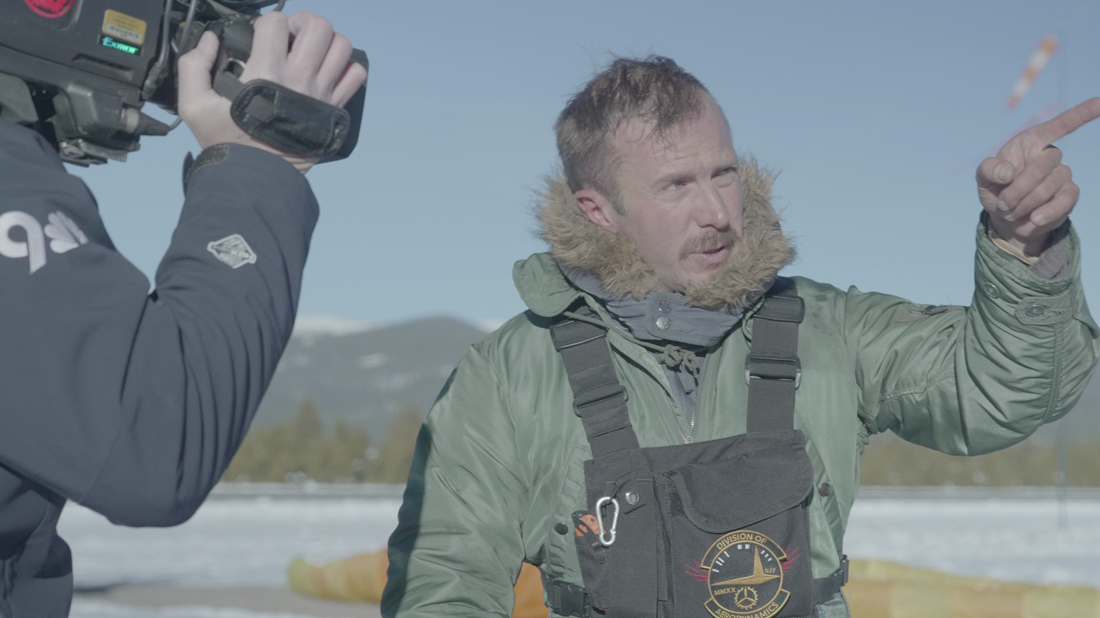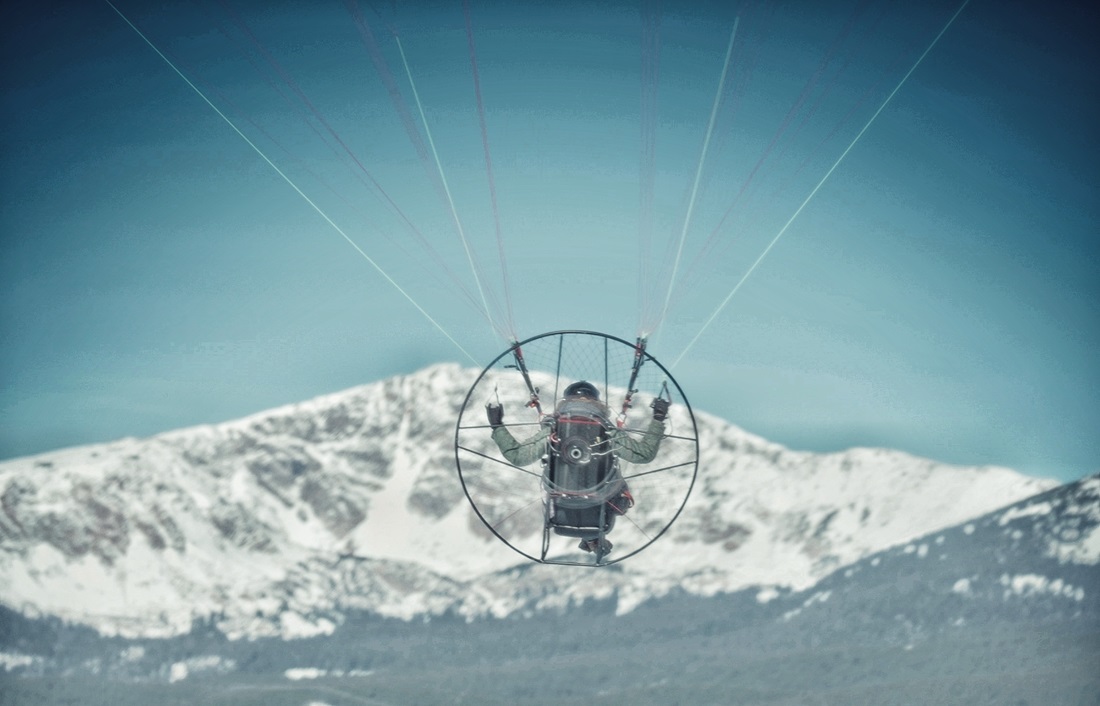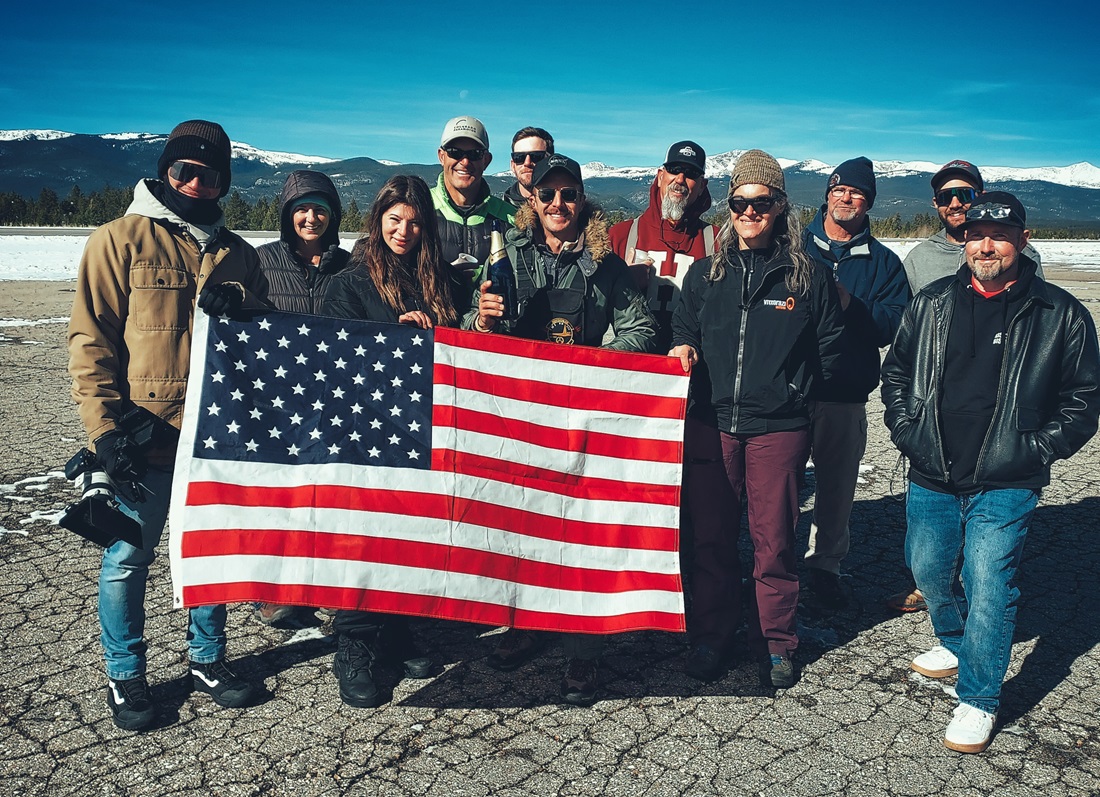A new world first: Nathan Finneman's altitude record in electric paramotor
FAI has recently ratified the very first FAI world record for altitude in the electric paramotor category. Pilot Nathan Finneman and a small team braved a cold Autumn day in Colorado, USA, to attempt an electric paramotor altitude record. Despite the risk of frostbite and some challenging meteorological conditions, Finneman and his team successfully set a benchmark of 4,508m in this new category, paving the way for future electric paramotor records.
As of September 2024, there are just six electric paramotor records ratified by FAI (including Finneman's):
RPL1E (1 person landplane)
- Distance in a straight line without landing, Daniel Tydecks, 2022 (63.20km)
RPF2E (2 people foot-launched)
- Distance in a straight line without landing, Peter Schulz and passenger, 2010 (17,2 km)
RPF1E (1 person foot-launched):
- Distance in a straight line without landing, Sylvain Moisseron in 2010 (39,78 km)
- Distance in a straight line without landing, Peter Schulz in 2010 (60km)
- Distance in a closed circuit without landing, Peter Schulz in 2010 (30.4km)
- Altitude, Nathan Finneman in 2024 (4508m)
Finneman's record is the first to be set for altitude using either a foot launch or trike launch electric paramotor. After ratifying this inaugural altitude record, we asked him to talk us through this major accomplishment in greener energy aviation.
Congratulations to you, Nathan, and the team that helped you. What inspired you to attempt this altitude record with an electric paramotor?
Setting records has been a goal of mine for many years. With the innovation of new advances in technology, comes new endeavour. One day I was flying my paramotor in Colorado with some friends, and we hatched a plan to set a benchmark altitude for an Electric Paramotor.
Could you talk us through the equipment you used?
The heart behind this aircraft is the SP140 V2.0, one of the newest electric paramotors on the market. Its build quality and design is fantastic. The lightweight frame, including the 4.8Kwh battery, paired with 175lbs (79kg) of thrust from the electric motor truly provides an impressive climb rate. Given the fact that it’s electric, the motor doesn’t lose power with altitude, unlike an internal combustion engine.
The wing I used for this attempt was actually not my original planned wing. With the winds aloft, predictions at my target altitude being over 40kts+, I decided to fly my trusty 18m Gin Carve. Its stability and capability to penetrate high winds made it the best choice for this attempt. But I was concerned that its altitude climbing abilities would suffer given how small it is. If I was to do it again, the original planned 30m wing would be my choice as it would yield 35% more altitude.
The most vital part of this attempt was the onboard equipment used to data log and record this attempt. We used three FAI-approved altimeters, so that if one failed, we would still have data from another. Without these sealed altimeters, this record would not be valid.
The temps at my altitude in the Rocky Mountains at the time of year meant it would be very cold. We had planned for -3 Fahrenheit (-19C) not including windchill, so I used an Air Force issue high altitude insulated flight suit, paired with heated gloves, insulated boots, and my flight helmet with insulated head gear and an oxygen mask.

What did you think the main challenges would be? And were there any other challenges that arose?
Truly the weather was our biggest challenge at the time; we planned several weeks in advance to find a good weather window.
The altitudes we were going for are very unpredictable given how quickly the weather can change in the mountains. Originally the winds aloft were predicting the day before at 20kts. That night when we were monitoring the air, the winds aloft were increasing rapidly. Our window to do this attempt was very small, as the winds were predicted to spike to 75kts+ at our target altitude.
The second challenge we were facing was the temperature. This record attempt was to take place in the late fall as it provides the most stable atmosphere. Mountain flying can turn deadly in a matter of minutes if the air becomes unstable. Spring and summer months are the most unstable conditions for flying, so we had to sacrifice temperature for air stability.
We had predicted the temperatures would be around -1 to -3 Fahrenheit (down to -19 C) at my target altitude, not including windchill. This is normally not detrimental to the engine of the aircraft if it is internal combustion. However, temperature affects battery life immensely. In fact for every 10 degree loss in temp, we had planned to lose 6 minutes of flying time due to power loss. That meant that my target altitude would have to be reached in a matter of minutes before battery cut off due to temps.
I also couldn’t just hold full throttle for the entire flight, that would kill the battery very quickly and the ultimate altitude would not be reached. Therefore we had to strategically plan the best throttle position for a climb rate that would be sufficient for maximum battery and altitude achieved. For this reason, my flight specialist, Jeremy, kept the battery charged and heated to retain the most charge internally right up until the point of take-off.
The biggest challenge that arose were the temperatures and winds were progressively worse in climb out and at altitude than anticipated. At the coldest point of the flight the temp and windchill gave us temperatures of -14 Fahrenheit (-25.5 C) and winds aloft were 34kts+. My electrically heated gloves I originally was going to wear were too bulky to work with the throttle control, so I sacrificed warmth for thinner gloves to fit the paramotor throttle into my hands.
This was a mistake, as mid climb into my flight, my hands were very cold. To make matters worse, I had taken off my left glove to check my external altimetre to see what the altitude was and the power remaining on my battery. I then realised I couldn’t get my glove back on without letting go of my wing controls. The turbulence was significantly bad, to the point I was doing everything I could to keep the paraglider from collapsing. I only had seconds to get my glove back on before frostbite would set in and cause permanent damage. I somehow managed to get my glove back on after an agonising 30 seconds, only then to fight relentless turbulence all the way until another mistake was made when I was adjusting my harness.
I had accidentally hit the power cut switch, and I couldn't get the control module to come back online. Not only was I fighting very strong headwinds with a dead paramotor, but I had not reached a satisfactory altitude. To make matters worse, I was being blown away from my original take off location. I immediately went into reflex mode on the paraglider trim settings, and tried dropping to a lower altitude in hopes the winds were calmer at a lower altitude.

That plan worked, and I was able to glide back to the landing zone. My hands were hurting badly, but I was not happy with where we were altitude wise.
Therefore I instructed Jeremy to plug the battery in and try to get any charge percentage increase to go up for a 2nd attempt. I knew the winds aloft were getting worse by the minute, but I also knew we didn’t reach an altitude that was satisfactory.
Leah Catullo, our FAI observer, also had a concern: the altitude data logs we had gathered from our first flight from the sealed altimeters were not showing any data from the prior flight. My heart sank.
Either something was wrong with the altimeters or the data that was being recorded was corrupt. She advised us to cross our fingers and hope that they were just in record mode and not showing any flight tracking until they are powered down.
So after half an hour of getting feeling back in my hands, Jeremy came back with a semi charged and warmed battery. I was at 65% battery. Not 100%, but given the circumstances, I would take any charge increase we could get. With the help of the crew, I strapped the paramotor back on my back, had the wing prepped and I took back off for attempt number two. The turbulence had increased significantly, but I was determined to get to the highest altitude that day.
I kept the throttle at 68%, with the trimmers on my paraglider set to best climb. Amazingly the battery life had lasted way beyond what we had planned, and at 28 minutes into the flight at an altitude of over 14790 feet (4508 metres) the battery power cut out.
I looked around, and took in the sights for we did everything we could to make this world record attempt happen. The glide down was uneventful minus a few wing collapses from turbulence. I landed back at the landing zone, the sealed altimeters were removed by the FAI observer and I was welcomed by an amazing team, family, and friends.
To our relief, once the data was downloaded, all the altitude points had been recorded. They hadn’t shown before as they were still recording. That was the biggest feeling of relief for me! Right then and there I knew we had put an American flag on the record books. Though it was not our target altitude, it was still a benchmark altitude that allowed us to demonstrate the capabilities of an electric paramotor.

What’s your story in aviation, how long have you been a paramotor pilot?
I have been flying since childhood. I flew hang gliders for a brief amount of time before I got tired of climbing to the top of a mountain only to have the winds change. Paramotors came into my life around 2010 and have been an instrumental part of my life. From flying all over the world, to representing Team USA in the FAI world paramotor slalom championships, to flying airshows nationally, paramotoring has truly changed the way I look at flying: the amazing people I have met along the way, the absolutely incredible adventures that have been experienced… There truly isn’t another sport that has come close to the incredible feeling that flying paramotors has given me. I love flying airplanes, but there is a part of my soul that yearns to fly paramotors and forever will.
This is the very first electric paramotor altitude record, what was your reaction on learning it had been ratified by FAI? And how do you think the record is important for the future of the sport?
This is very exciting for us, the first world altitude record for an electric paramotor. It was also a proud moment seeing an American flag go up for an official world record.
This would never have happened without the incredible help of our team, dedicating their time and resources. All the credit goes to them, I was just nutty enough to squeeze the throttle and attempt to make it back in one piece unfrozen. I hope this achievement will only influence other pilots to attempt world records to further innovate the sport.
Do you have any other plans for record attempts?
Absolutely, in fact we have already devised a plan to go even higher. With the help of the FAA and some airspace clearances, that may just happen sooner than planned. I will however this second go around devise a much better way to keep my hands warm, such as keeping my gloves on.
Any final words for anyone thinking of taking on an electric paramotor record in the future?
Never stop pushing the limits, and most of all: have fun doing it!
Photo/Video Credit: Christian Ojala

